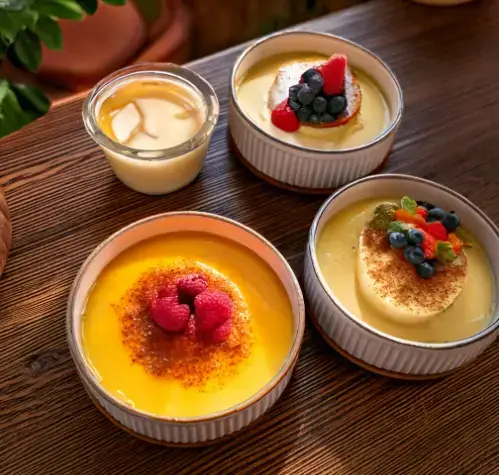Introduction : Exploring the 3 Types of Custard: Baked, Stirred, and Set
Custard is a beloved dessert known for its creamy texture and rich versatility. Whether used to fill pastries, top pies, or enjoyed on its own, custard adds a luxurious flavor that enhances any dessert. It’s a key ingredient in classic treats like crème brûlée, tarts, and trifles, making every dish feel indulgent. But did you know there are actually 3 types of custard? Understanding the differences between these three variations—baked, stirred, and set custard—will help you choose the right type for your recipe. By knowing when to use each, you’ll be able to perfect your custard creations every time.
In this article, we will explore the 3 types of custard, providing you with insights on their unique characteristics, preparation methods, and common uses. By the end of this guide, you’ll feel confident working with each type and will be ready to add this creamy delight to your next dessert.
Learn about the 3 Types of Custard and their unique uses in desserts.
The 3 Types of Custard: A Quick Overview
Understanding the 3 Types of Custard: Baked, Stirred, and Set
The 3 types of custard—baked, stirred, and set—each bring something special to the table. Each type has a distinct texture, preparation method, and role in dessert making.
- Baked Custard: Firm and cooked in the oven, it’s perfect for structured desserts like crème brûlée or flan.
- Stirred Custard: Cooked on the stovetop, it remains creamy and pourable, ideal for sauces and fillings.
- Set Custard: This gelatin-based custard firms up when chilled, making it perfect for molded desserts like panna cotta.
Each type of custard serves a specific purpose, so learning how to prepare them correctly will take your dessert game to the next level.
Baked Custard: One of the 3 Types of Custard You Should Know
What Makes Baked Custard Unique?
Baked custard is known for its firm yet creamy texture. To prepare this type of custard, you’ll mix eggs, sugar, and milk or cream, then bake it slowly in the oven. What makes baked custard special is its cooking method. It’s traditionally cooked in a water bath, or bain-marie, which ensures even heat distribution and prevents curdling. This slow, gentle heat allows the custard to set while maintaining its smooth, velvety texture.
Importantly, baked custard doesn’t require constant stirring, but careful monitoring is necessary to avoid overheating. The slow cooking process results in a custard that holds its shape well, making it perfect for desserts like crème brûlée or flan.
Popular Desserts Made with Baked Custard
Many classic desserts feature baked custard, such as:
- Crème Brûlée: This iconic dessert is known for its caramelized sugar crust and silky custard base.
- Flan: A firm custard topped with rich caramel sauce, often served chilled.
- Pot de Crème: A French dessert served in small pots, with flavors like vanilla or chocolate.
These desserts showcase the luxurious texture of baked custard, making them favorites in fine dining and home kitchens alike.
How to Prepare Baked Custard
To make perfect baked custard, follow these steps:
- Mix eggs, sugar, and milk (or cream) until smooth.
- Strain the mixture to remove any bubbles or impurities.
- Pour the custard into ramekins and place them in a water bath.
- Bake at 300°F (150°C) until the custard is set but slightly jiggly in the center.
Pro Tips for Perfect Baked Custard
- Always use a water bath for even heat distribution.
- Bake at low temperatures to avoid overcooking.
- Test doneness by gently shaking the custard; a slight jiggle means it’s ready.
Stirred Custard: Another Essential Among the 3 Types of Custard
Why Choose Stirred Custard?
Stirred custard is ideal when you want a creamy, pourable texture. Unlike baked custard, stirred custard is prepared on the stovetop. By cooking the mixture over low heat while stirring constantly, the custard thickens into a smooth and silky texture. This makes stirred custard perfect for sauces, fillings, and creamy bases.
Famous Stirred Custard Recipes
Some well-known recipes that rely on stirred custard include:
- Pastry Cream: Used as a filling for éclairs, tarts, and cream puffs.
- Crème Anglaise: A vanilla custard sauce often served over cakes or fruits.
- Sabayon: A frothy, wine-based custard typically paired with fruits or desserts.
These dishes demonstrate the versatility of stirred custard, as it can serve a variety of roles in both sweet and savory dishes.
How to Make Stirred Custard
Here’s how to make stirred custard:
- Whisk egg yolks, sugar, and milk together in a saucepan.
- Heat the mixture over medium-low heat, stirring continuously to prevent curdling.
- Strain the custard to remove lumps and ensure smoothness.
- Allow it to cool before using it as a filling, topping, or sauce.
Tips for Perfect Stirred Custard
- Stir constantly to prevent curdling.
- Use low heat to avoid scrambling the eggs.
- Test readiness by checking if the custard coats the back of a spoon.
Set Custard: The Third of the 3 Types of Custard for Molded Desserts
What Sets Set Custard Apart?
Set custard is unique because it’s thickened using gelatin or agar-agar instead of eggs. This type of custard doesn’t require baking or stovetop cooking. Instead, you’ll heat the mixture and then chill it to firm up in the fridge. The result is a delicate yet firm custard that can be molded into various shapes.
Set custard is perfect for elegant desserts that need to hold their shape, such as panna cotta or blancmange.
Famous Desserts Featuring Set Custard
Set custard is a key component in several luxurious desserts:
- Panna Cotta: A creamy custard dessert often served with fruit or syrup.
- Blancmange: A traditional custard, often flavored with vanilla or almonds.
- Bavarian Cream: A custard made with gelatin, perfect for molding into sophisticated shapes.
These desserts highlight the versatility of set custard, allowing it to take on different flavors and textures while remaining firm and moldable.
How to Make Set Custard
To prepare set custard:
- Heat milk or cream with sugar and flavorings of your choice.
- Dissolve gelatin in warm liquid and stir it into the mixture.
- Pour the custard into molds and refrigerate until fully set.
Tips for Perfect Set Custard
- Use the correct gelatin-to-liquid ratio for the desired firmness.
- Allow the custard to chill completely for the best results.
- Experiment with different flavors like chocolate, fruit, or coffee.
How to Choose the Right Type of Custard for Your Dessert
Knowing the 3 types of custard allows you to select the ideal one for your dessert:
- For sauces or fillings: Stirred custard, like crème anglaise or pastry cream, works best.
- For firm, sliceable desserts: Baked custard, such as crème brûlée or flan, is perfect.
- For molded desserts: Set custard is the go-to option for panna cotta or Bavarian cream.
Avoid Common Mistakes When Making the 3 Types of Custard
Even experienced bakers encounter challenges when making custard. Here are some common mistakes to avoid:
- Prevent curdling: Stir constantly, and use low heat to avoid overcooking.
- Avoid overcooking: Keep a close eye on the texture to ensure it’s smooth and creamy.
- Use a water bath for baked custard: This helps ensure even cooking and prevents curdling.
- Let set custard chill properly: Always refrigerate until the custard has set completely.
Conclusion: Master the 3 Types of Custard for Perfect Desserts
Mastering the 3 types of custard—baked, stirred, and set—opens up a world of dessert possibilities. Whether you’re preparing a rich sauce for drizzling over cakes and fruits, crafting a firm and indulgent crème brûlée with its signature caramelized sugar crust, or creating a perfectly molded panna cotta that wobbles just the right amount, knowing how to perfect these custards will elevate your baking and dessert-making skills. Each type of custard brings a unique texture and flavor to the table, and understanding how to work with them will make you feel more confident in the kitchen.
Impress Your Guests with Perfect Custards
With the right techniques and tips, you’ll be able to impress your guests with every dessert you make. The versatility of custard allows it to be used in so many different ways—whether you’re looking for something rich and velvety or light and airy, there’s a custard for every occasion. As you become more familiar with each type of custard, you can experiment with flavor variations, add-ins, and presentation ideas to create your own signature desserts.
A Deeper Understanding of Custard for Better Baking
Moreover, mastering these 3 types of custard not only broadens your dessert repertoire but also helps you understand the core principles of baking and dessert preparation. By learning the specific cooking methods for baked, stirred, and set custards, you gain an invaluable skill set that you can apply to other recipes, too. With every batch, you’ll gain a deeper appreciation for the art of custard-making and discover just how easy it can be to create professional-level desserts at home.
Choose the Best Custard for Your Recipes
By understanding the nuances of each custard type, you can confidently choose the best option for your recipes. Whether you’re preparing a classic French dessert, a creamy filling for your favorite pastries, or a decadent, chilled treat for summer gatherings, knowing which custard to use will ensure your success. This knowledge will allow you to create a variety of decadent treats that will not only leave your guests asking for seconds but also impress them with your culinary expertise and attention to detail.
Unlock Endless Creative Possibilities in the Kitchen
In the end, becoming proficient with the 3 types of custard will open the door to endless creative possibilities in the kitchen. Your desserts will no longer be limited to just the basics; instead, you’ll be able to craft intricate, delicious custard-based creations that are sure to delight anyone who takes a bite.
FAQs
What are the different types of custards?
The 3 main types of custard are:
- Baked Custard: These firm custards, like crème brûlée or flan, are set by baking in the oven. The gentle heat helps them firm up while maintaining a smooth, creamy texture.
- Stirred Custard: These custards, like pastry cream or crème anglaise, are creamy and pourable. They are made on the stovetop with continuous stirring, allowing them to thicken while remaining smooth and silky.
- Set Custard: Moldable custards, like panna cotta, are set using gelatin or agar-agar and chilled in the fridge. This type of custard creates a firm but delicate texture that holds its shape when unmolded.
What is the fancy name for custard?
The fancy term for custard depends on the specific type. Crème pâtissière refers to pastry cream, which is commonly used as a filling for pastries. Crème anglaise is a term used for a vanilla custard sauce. These French names are often used in more refined culinary contexts.
What is custard called in America?
In America, custard typically refers to a creamy dessert made from eggs, sugar, and milk, with a rich, velvety texture. Additionally, frozen custard is a type of soft-serve ice cream that contains egg yolks, making it smoother and richer than regular ice cream.
What’s the difference between egg custard and custard?
Egg Custard refers specifically to a custard made with eggs, sugar, and milk. While all custards contain eggs, egg custard often highlights this ingredient, especially in recipes where the eggs are essential to the custard’s consistency and flavor.

